by Meenakshi Advani VRai, ACIW Mumbai
Piopiotahi or Milford Sound
 Rudyard Kipling called Milford Sound, or Piopiotahi, “The Eighth Wonder of the World.” It was named by the Māoris after an extinct bird, the piopio, and means “a place for the singing thrush.”
Rudyard Kipling called Milford Sound, or Piopiotahi, “The Eighth Wonder of the World.” It was named by the Māoris after an extinct bird, the piopio, and means “a place for the singing thrush.”
Vivek and I flew 11,929 km to see this iconic natural phenomenon. When asked, “Is it worth a visit? Is it as spectacular as they say it is?” my answer is “Yes, definitely!”
The Mitre Peak cruise ride into the dramatic fiordland infused us with a meditative energy. The mountain is located at the northernmost end of Fiordland National Park on the South Island of New Zealand, reaching 1,683 m high and descending into waters nearly 400 m deep.
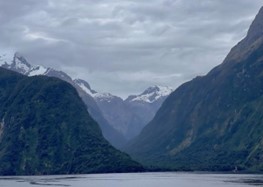 Milford Sound is a fiord, or sheer narrow valley opening out to the sea, with high cliffs on either side. It was carved out of the rocks by glaciers 20,000 years ago. At the peak of global glaciation, small portions of the mountains were exposed to ice. As temperatures rose and the planet warmed, the glaciers retreated and sea levels rose, filling Milford Sound with water, long before humans visited.
Milford Sound is a fiord, or sheer narrow valley opening out to the sea, with high cliffs on either side. It was carved out of the rocks by glaciers 20,000 years ago. At the peak of global glaciation, small portions of the mountains were exposed to ice. As temperatures rose and the planet warmed, the glaciers retreated and sea levels rose, filling Milford Sound with water, long before humans visited.
The Alpine Fault, one of the largest plate boundary faults, crosses the mouth of Milford Sound. The Australian plate slides sideways and is pushed beneath the Fiordland at 36mm/year, forcing Pacific Plate rocks upwards to form the mountains. Earthquakes occur to depths of 200 km.
Calm Sea, Wind and Rain
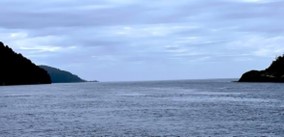 Deep-water emergence is the phenomenon where marine species normally found at great depths (i.e., below 200 m), can be found in significantly shallower depths due to unique conditions. Milford Sound is protected by a narrow entrance and a shallow sill of glacial moraine that was left behind by a retreating glacier. This moraine acts like a buffer that minimizes the sea swells and surges, creating a relatively calm underwater environment.
Deep-water emergence is the phenomenon where marine species normally found at great depths (i.e., below 200 m), can be found in significantly shallower depths due to unique conditions. Milford Sound is protected by a narrow entrance and a shallow sill of glacial moraine that was left behind by a retreating glacier. This moraine acts like a buffer that minimizes the sea swells and surges, creating a relatively calm underwater environment.
The lack of ocean swells, the lack of sediment and the low light conditions allow deep-sea creatures and plant life to thrive at shallower levels. An example of this is black coral, which are white in color when alive, that grow here at shallow depths. Some larger colonies are thought to be hundreds of years old.
Tea-Coloured Fresh Water
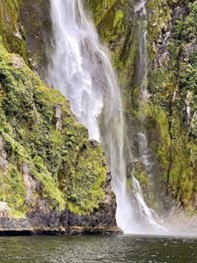
Rainfall also contributes to the environment. Moisture-laden westerly winds sweep across the Southern Ocean and Tasman Sea and are deflected upwards by the cliffs on the west coast of Fiordland. As the air rises and cools it releases moisture as rainfall.
The heavy rainfall and surrounding rainforest create a unique effect. Numerous waterfalls and large river catchments that flow into Milford Sound channel massive amounts of fresh water into the fiord, giving it a distinctive water composition.
Its narrow and shallow entrance slows the flow of fresh water to the sea, trapping a top layer of fresh water. This generates a clear, tea-colored rainwater that washes down the mountain cliffs into the fiord. Most of the water is salty from the Tasman Sea, except the top 10 meters of surface fresh water, which are stained with tannins from the soil and the vegetation growing on the cliffs. The inky-dark, reflective top water and deep sea water decrease light and stop it from penetrating the depths below.
The phenomena of trees growing in a rich layer of humus and leaves on the thin to non-existent soil layer that clings to the sides of the fiords is a large part of its splendor.
Milford Sound contains a rare and extremely fragile ecosystem.
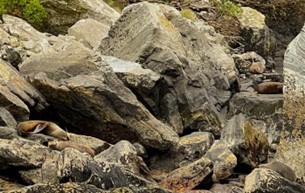 Milford Sound is one of the wettest places on earth with an average annual total of 700 cm of rain or snow falling on 182 days a year. When the rain comes, the mountains are covered in hundreds of temporary waterfalls, spilling down from the mists.
Milford Sound is one of the wettest places on earth with an average annual total of 700 cm of rain or snow falling on 182 days a year. When the rain comes, the mountains are covered in hundreds of temporary waterfalls, spilling down from the mists. - Thickly forested slopes keep the water clean and provide an important source of food for underwater life.
- Fiords are sheltered from big waves and ocean swells. The fresh water cannot mix easily with the denser sea water, but flows over the surface towards the sea.
- Dusky and bottlenose dolphins regularly visit the fiord, while humpback and southern right whales sometimes pass by on their migration south for the summer.
- New Zealand fur seals, once nearly hunted to extinction, are now plentiful, basking in the sun on crystalline metamorphic rocks, such as gneiss and schist, as well as volcanic rocks such as granite.
- An elusive creature, the rare Fiordland crested penguin, is sometimes seen in season.
- Piopiotahi Marine Reserve was created in 1993 to protect the wildlife, provide a home to tubeworms, shellfish, sponges, anemones, starfish, snake stars, as well as other species.
- Brachiopods, a primitive shellfish that evolution forgot, as they are more closely related to ancient fossil shells than other clams, are found here.
- Spiny starfish move over the underwater landscape, nibbling on seashells.
- Colourful anemones hang like Christmas garlands from the trees of coral.
- Fiordland has its own species of black coral called “antipathes fiordenis,” which thrive here at 10 meters’ depth, are normally found at up to 75 meters. There are about seven million coral colonies in Milford Sound that have been building their underwater forests here for 200 million years!
- Black coral, treasured and harvested since ancient times, are now protected in most areas where they are found. When dried and polished, the branches can be turned into beautiful jewellery. Left undisturbed, black coral can live for over 300 years.
- Milford Sound is home to pounamu or greenstone, also known as nephrite or jade.
- It is illegal to remove any organisms, living or dead, from the reserve.
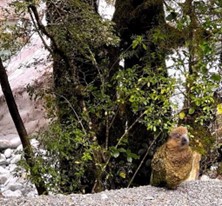 Besides the gorgeous native trees, plants, flowers and landscapes, we spotted a kea bird on our drive to Piopiotahi. After a quick glance to my “hello,” it went on merrily catching sandflies.
Besides the gorgeous native trees, plants, flowers and landscapes, we spotted a kea bird on our drive to Piopiotahi. After a quick glance to my “hello,” it went on merrily catching sandflies.
In Māori folklore, the goddess of death, Hinenui-te-Po, released sandflies – called te namu, or little devils – into Milford Sound, to keep people away. She feared the landscape created by Tu-te-raki-whanoa was so glorious that people would want to live there forever.
The Harrison Cove floating underwater observatory is the only one of its kind in New Zealand.
We were fascinated by the underwater environment of the Marine Reserve at the Fiord – where life on land and life below water work in perfect harmony.
Milford Sound, our planet’s true gem!
References and further information:
- Geology, Flora And Fauna Of Milford Sound | Mitre Peak Cruises
- 8 reasons why Milford Sound is a ‘Must Do’ in New Zealand
- Milford Sound Underwater Observatory
- Bringing you to Piopiotahi / Milford Sound for 20 years
- Kea the Clever Clown of the Alps | Milford Sound
- Milford Sound Marine Life | Milford Sound Lodge
- Milford Sound | Wikipedia
- Nature and conservation of Fiordland National Park | Department of Conservation
Photos by Meenakshi Advani VRai

